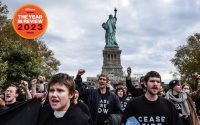At Christie’s Art + Tech Summit, A.I. Dominated But There Were Few Answers About its Utility
When Apple co-founder Steve Wozniak took the stage for the final talk on Wednesday at the Christie’s Art + Tech Summit, a sea of iPhones rose into the air to photograph tech’s living legend. And while Wozniak came off as the archetypal excitable inventor, he quickly bemoaned tech companies’ recent turn away from making reliable, problem-solving products.
“I see two digital worlds,” Wozniak said. The first, he said, was the moment he came up in, dominated by the invention of new products people could buy. The second is the present, with its focus on endless updates and subscription plans. It’s perhaps no surprise then that Wozniak spoke fairly derisively about artificial intelligence, an ill-defined, hyped technology with vague applications that has nevertheless raked in hundreds of billions of dollars in private capital (as well as government subsidies) in the US alone, according to the Stanford Institute for Human-Centered Artificial Intelligence.
“I used to ride my bicycle over to the Stanford campus to watch a machine pick up a blue ball and put it into a blue box,” Wozniak said. “It only understood simple rules and now it understands more.”
Wozniak openly struggled with the imbalance between the value of the new technology and the investment it has garnered, not to mention the high costs it incurs—and he wasn’t the only one at the conference to do so.
Though Kevin O’Leary of Shark Tank fame said he made a nice chunk of change investing in NVIDIA, a leading AI company, he spent most of his talk focusing on buying watches, advertising on cable, and doing business in the UAE. When it comes to AI, O’Leary said, the industry is quickly approaching the “show me” phase and finding out that most of what hyped-up tech founders call AI is really just run-of-the-mill data mining and science.
“So, not so fast bubble–ooey,” he said. “Show me how it works and where I get my return.”
O’Leary’s suggestion that the AI investment bubble is about to pop echoes a fairly pessimistic report released in June by Goldman Sachs titled “GenAI: Too Much Spend, Too Little Benefit?” In the report, Goldman Sachs’ Head of Global Equity Research Jim Covello was quoted saying, “Truly life-changing inventions like the internet enabled low-cost solutions to disrupt high-cost solutions even in its infancy, unlike costly AI tech today.” Other analysts quoted in the report said that AI’s “killer application” has yet to emerge and that it would take another ten years for its applications to become cost-effective.
A lack of clear-cut applications makes the energy expenditure in AI seem all the more irrational. As tech consultant Sol Rashidi mentioned in the “Real Applications of AI” panel at Christie’s, OpenAI alone uses the equivalent of double the annual energy needs of France in a single year. He added that the US grid would have to be completely rehauled to meet the energy demands necessitated by mass adoption of AI. (Oddly enough, neither of the panelists on another talk, “The Role of Art in the Sustainability Discourse,” had anything to say about that).
Still, other panelists at the summit groped for AI’s applications. In three separate panels, Randy Hunt, head of design at Notion, Ashley Ferro-Murray, program director for the arts at the Doris Duke Foundation, and Dr. Zhou Yu, co-founder of Articulate.AI, pointed to AI’s potential to increase productivity.
“The AI can do the most tedious tasks and the humans can do the complex tasks and decision making. It will act as a complement to human teams,” Zhou said, trotting out the usual line at the “AI: From Research to Practice” panel.
Meanwhile, numerous panelists obliquely referred to the fears around AI, offering reassurances without ever saying the words automation, labor, climate change, or super-intelligence. At the same panel as Zhou, Dr. Sanjeev Arora, a computer science professor at Princeton University, typified this vagueness.
“There are these big sci-fi-like questions we’ve been asking and … it’s still an open question,” he said. “We need more understanding and science about its capabilities that are not understood, we need some science and quantification. This tech is developed in a black box way.”
Not so reassuring. But regardless, what does any of this have to do with art? The one place in which AI has been adopted by users is in the creative realm, as multiple speakers noted.
“The creative space is where AI has had the biggest impact and I don’t think anyone could have predicted that,” Bob Muglia, the former CEO of the AI data cloud company Snowflake, said. Two years ago, at a past edition of the Christie’s Art + Tech Summit, crypto VC and ARTnews Top 200 collector Ryan Zurrer said almost exactly the same thing about NFTs: “No OG in the crypto space ever predicted that it would be art that brought us into the mainstream.”
Yet despite the similarities in the respective hype-cycles of NFTs and AI—the primary one being that their use in the creative realm brought the technology into the daily lives of regular users, at least for a little while—things are playing out differently this time around. NFTs attracted many digital artists and technologists because it promised to solve a concrete problem: how to value, buy, and sell digital content and art. While AI is perhaps even more highly valued than NFTs ever were, its use-case is much murkier.
At the summit, there was a striking lack of leaders from AI companies working on text-to-image or text-to-video generative AI. Those figures’ absence was interesting in the face of an already occurring—and supposedly, soon to expand—application of generative AI to the production of films, commercials, advertisements, slogans, articles, novels, and comics, as well as the attendant debates about automation in creative industries. Even on the panel “AI and the Future of Human Creativity,” the conversation stuck to whether or not AI can “truly” be creative when the fact is that generative-AI outputs are already being consumed by audiences on a mass scale. That uncomfortable and inconvenient reality was roundly ignored by the panelists.
Instead of hearing from executives at generative AI companies, the summit’s talks featured a number of artist-researchers–Alexander Reben and Refik Anadol, among others–who are developing their own AI tools for their art practices. Centering that non-threatening work is a pointed choice when there are AI companies like Runway, a video generation company, poised to supplant scores of creative industry jobs.
Toward the end of Wozniak’s talk, moderator and Global Head of Christie’s Ventures Devang Thakkar asked the tech luminary what he would do differently if he could do it all over again. “Pay more attention to business ethics,” Wozniak said firmly.
Though Wozniak was speaking about concerns over monopolies, the lesson might easily be extended to looming concerns about AI and worker obsoletion. But Wozniak left Apple in 1985, and it’s the “move fast and break things” acolytes of Steve Jobs who run the industry now.



